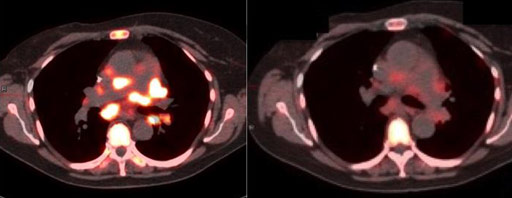Increased NIV Molecular Imaging Technologies Needed for Cancer Care
By MedImaging International staff writers
Posted on 10 Jan 2017
According to researchers in the US, new molecular imaging technologies can facilitate the diagnosis, monitoring, and treatment of cancer, while at the same time reducing the frequency of unnecessary or ineffective therapies and minimizing side effects.Posted on 10 Jan 2017
The new non-invasive molecular imaging technology can also complement biopsy data in cancer care, in cases where multiple examinations are necessary.

Image: The image on the left is from before therapy, and the image on the right from three days after treatment (Photo courtesy of Penn Medicine).
The researchers from the Abramson Cancer Center (PENN Medicine; Philadelphia, PA, USA), and the Perelman School of Medicine, University of Pennsylvania, (Philadelphia, PA, USA) published the review online on December 29, 2016, in the journal JAMA Oncology.
According to the authors, molecular imaging can have several significant impacts. These include helping identify patients that would benefit from targeted therapy, monitoring drug movement in the body and helping to guide drug dosing while minimizing side effects. Molecular imaging can also be used to monitor the effectiveness of drug treatments. The combined data can help predict patient outcomes and overall survival.
Lead author of the study, David A. Mankoff, MD, PhD, said, "Many of these methods are already being studied in clinical trials, but the path from clinical trials to routine clinical use is seldom easy. Molecular imaging methods face some particularly challenging hurdles such as the need to deliver the short-lived imaging probes to centers performing the imaging. We don't have a good framework yet for moving these potentially powerful diagnostic tools into routine clinical use. Among other things, we need to bring the imaging and oncology communities together to find the best way forward. In that case, molecular imaging could have directed treatment to patients highly likely to benefit and spared many other patients the toxic effects and costs of ineffective therapy."
Related Links:
Abramson Cancer Center
Perelman School of Medicine














